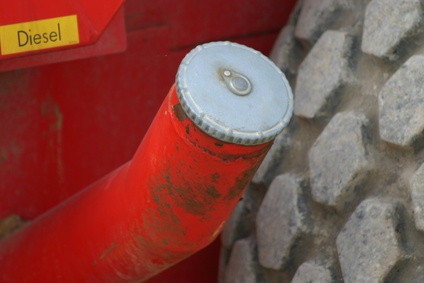
Diesel engines have better fuel economy and produce more low-end torque than gasoline engines. One of the disadvantages of diesel fuel is that it absorbs water, which can cause metal particles in the engine to rust and clog the fuel injector. Diesel engines come with a fuel water separator that filters and separates water and other impurities from the diesel fuel so you can achieve maximum performance. Your Chevy truck has a sensor that indicates when you need to drain the water from the fuel water separator. You may need to change the fuel filter when you drain the water.
Remove the fender well located just above the front tire from the passenger side of the truck by pulling the plastic clips out. The clips are around the edge of the fender well and should be easy to remove by hand.
Locate the fuel water separator, which is built into the bottom of the fuel filter on the side of the engine. The fuel filter/ water separator is a round canister about 10-12 inches long and is usually white. Removing the fender well makes it easy to access the bottom of the fuel filter without opening the hood.
Unplug the sensor connector from the sensor, which is on the bottom of the fuel water separator. There is a plastic lock tab on the sensor connector that you need to bend back to release the connector so it can slide out.
Place the small bucket underneath the fuel water separator.
Loosen the threads on the plastic petcock valve on the bottom of the fuel water separator by gripping the valve at the top with a pair of slip-groove joint pliers and turning counter-clockwise. Turn the petcock valve carefully so you don't strip the threads.
Unscrew the petcock valve and O-ring seal from the bottom of the fuel water separator and set them aside. When you unscrew and remove the petcock valve, you will find the O-ring valve at the top of the threads to ensure a tight seal between the petcock valve and the fuel water separator.
Drain the water from the fuel water separator into the small plastic bucket.
Lubricate the O-ring with petroleum jelly to hold it in place and protect the rubber from pinching and drying out. Place a dime-sized amount of lubricating jelly on your finger, then rub the jelly around the ring on both sides to coat it evenly.
Put the O-ring back over the threads of the petcock valve and then hand-tighten them back into position on the fuel water separator. You are simply putting them back in place and will need to turn them clockwise until you can't turn them anymore.
Grip the petcock valve with the slip-groove pliers and turn clockwise to further tighten them onto the fuel water separator. Be careful not to over-tighten and strip the plastic threads.
Plug the sensor back into the sensor connector on the bottom of the fuel water separator in the same way that you removed it. The locking tab should lock back into place, but you might have to push it down to make sure it locks.
Re-attach the fender well to the truck by pushing the plastic clips back into the holes around the fender. You may need a second person to hold it in place so that it is properly aligned.
Open the hood of the truck to access the top of the fuel filter on the passenger side of the truck. This is a white canister with a silver or aluminum housing on top of it and rubber or metal fuel lines leading into it.
Prime the filter by pushing in on the metal primer plunger button on top until you can't push it anymore. This pumps fuel back into the fuel water separator so that the truck can start.
Pour the drained water into an old fuel can and take it to a fuel recycling center or an auto parts store that recycles fuel. Proper recycling prevents dangerous fuels from leaking into the water supply.